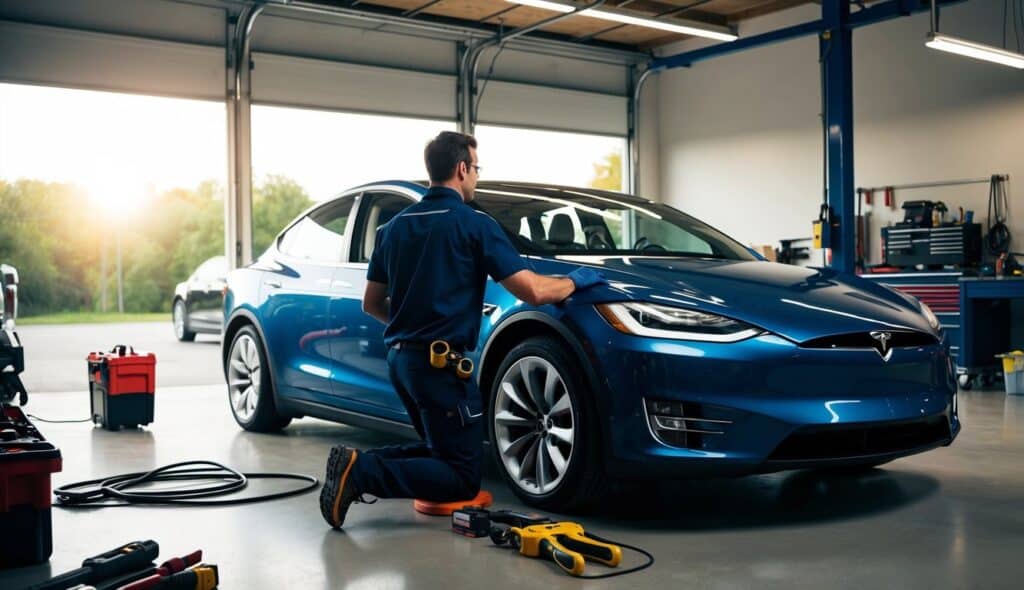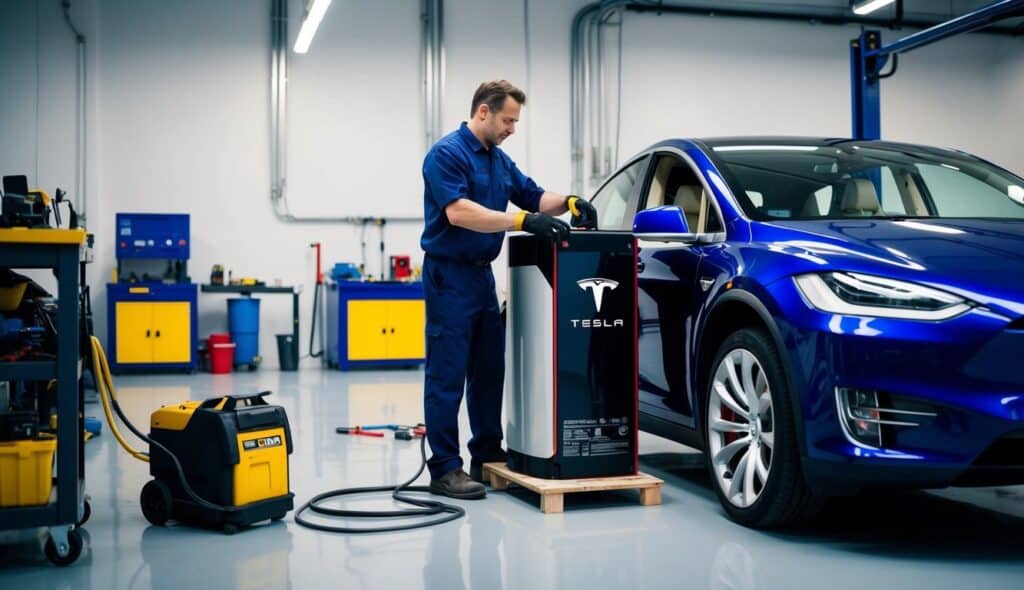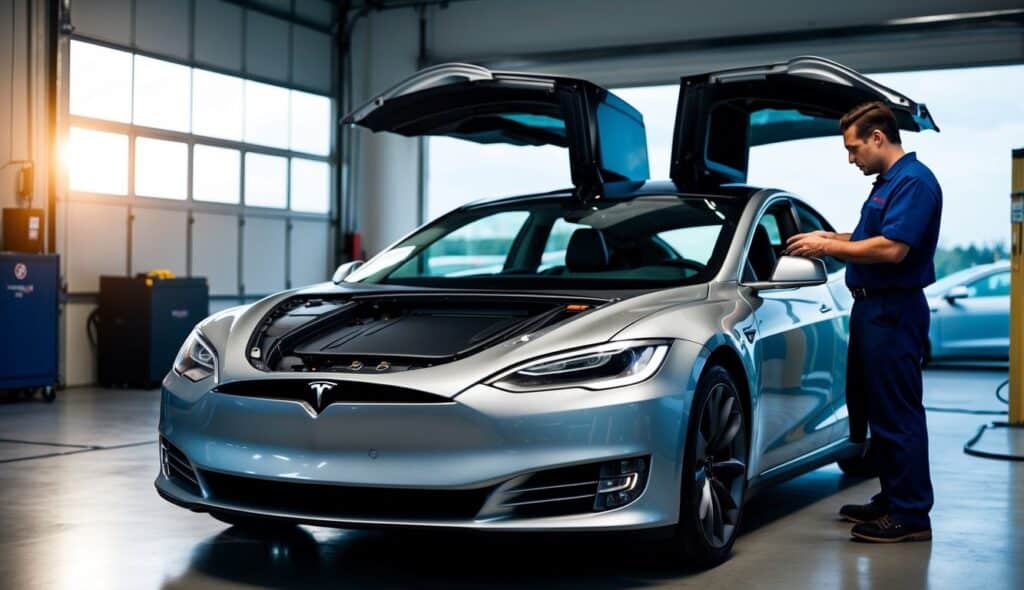Tesla owners often wonder about the cost of replacing their car’s battery. This is a key question, as the battery is a major part of any electric vehicle.
A Tesla battery replacement can cost between $13,000 and $20,000, depending on the model. This price includes both parts and labor. Model 3 and Model Y tend to be at the lower end of this range, while Model S and Model X are usually more expensive.
These costs apply when the battery is not under warranty. Tesla’s battery warranty covers 8 years or 100,000 to 150,000 miles, based on the model. Most Tesla batteries last 10 to 20 years, so many owners may never need to replace them. Still, knowing the potential costs for long-term EV ownership is smart.
Understanding Tesla’s Electric Vehicle Technology
Tesla’s electric vehicles use cutting-edge battery and motor technology. This allows for long driving ranges, quick acceleration, and efficient energy use. Let’s explore the key aspects of Tesla’s EV tech.

Tesla Models Overview
Tesla offers several electric vehicle models. The Model 3 is a popular sedan, the Model Y is a compact SUV, and the Model S sedan and Model X SUV are for luxury buyers. Tesla plans to release the Cybertruck, an electric pickup.
Each model has unique features. The Model 3 focuses on affordability and efficiency. The Model S offers high performance and long range. The Model X has falcon-wing doors and seats up to seven people.
All Tesla cars use touchscreens for most controls. They also get regular software updates to add new features.
Battery Technology in EVs
Tesla uses lithium-ion batteries in its electric cars. These batteries store a lot of energy in a small space, giving Tesla cars their long driving range.
The battery packs consist of thousands of small cells. Tesla makes some of these cells in-house, which helps control costs and improve technology.
Tesla’s batteries can charge quickly at Supercharger stations. Some models can gain over 200 miles of range in just 15 minutes.
Battery life is a key concern for EV owners. Tesla designs its batteries to last for many years. Most Tesla batteries retain over 90% capacity after 200,000 miles.
Comparison With Internal Combustion Engine
Electric motors in Teslas work very differently from gas engines. They provide instant torque, giving quick acceleration. This makes Tesla cars feel sporty to drive.
EVs have fewer moving parts than gas cars. This can mean less maintenance over time. There’s no need for oil changes or spark plug replacements.
Tesla cars are more energy-efficient than gas cars. They convert about 77% of electrical energy to power at the wheels. Gas cars only convert about 12-30% of fuel energy to power.
EVs produce zero direct emissions while driving. This helps reduce air pollution in cities. However, the overall environmental impact depends on how the electricity is generated.
Tesla’s Battery Replacement Details
Tesla batteries are designed to last many years but may eventually need replacement. The process involves some key factors to be aware of.
Symptoms and Causes of Battery Degradation
Tesla batteries can lose capacity over time. Signs include reduced driving range and longer charging times. Heat, frequent fast charging, and deep discharges can speed up degradation.
Cold weather may temporarily reduce range. Parking in the shade and avoiding extreme temperatures help preserve the battery. Tesla’s battery management system works to minimize degradation.
Sudden range drops or error messages could signal a faulty battery. The car should be taken to a Tesla service center for diagnosis in these cases.
Tesla Warranty Coverage
Tesla provides an 8-year or 150,000-mile warranty on Model S and X batteries. For Model 3 and Y, it’s 8 years or 100,000-120,000 miles, depending on the version.
The warranty covers battery defects and failures and guarantees at least 70% capacity retention during the warranty period.
Damage from accidents, misuse, or improper maintenance isn’t covered. Neither is normal degradation over time.
If a battery needs replacement under warranty, Tesla covers all costs. Outside warranty, owners pay for parts and labor.
Cost Factors for Tesla Battery Replacement
The price of replacing a Tesla battery depends on several key elements. These include the specific Tesla model, the size and capacity of the battery, and the cost of labor and service.
Model Specific Battery Costs
Tesla battery replacement costs vary by model. The Model 3 battery typically costs around $13,000 to $15,000 to replace. Model S replacements range from $13,000 to $20,000. Expect to pay at least $14,000 for the Model X. The Model Y’s battery replacement cost is similar to the Model 3’s, starting at about $13,000.
These prices can change based on the car’s age and the battery’s condition. Newer models may have more expensive batteries due to updated technology. Older batteries might be cheaper but could have reduced capacity.

Battery Size and Capacity Considerations
Battery size and capacity play a big role in replacement costs. Larger batteries with higher capacity cost more to replace. For example, a 100 kWh battery will be more expensive than a 75 kWh battery.
Tesla offers different battery sizes for their models:
- Model S: 75-100 kWh
- Model X: 75-100 kWh
- Model 3: 50-75 kWh
- Model Y: 75 kWh
A bigger battery means a higher price tag for replacement. But it also means more range and power. Buyers need to balance cost with their driving needs when picking a battery size.
Cost of Labor and Service
Labor and service fees add to the total cost of a Tesla battery replacement. These fees can range from $1,000 to $3,000 or more, depending on the service center and the work needed.
Some factors that affect labor costs:
- Time needed to remove and install the battery
- Any extra repairs or parts needed
- Location of the service center
Tesla’s mobile service may be able to replace some batteries on-site. This could save money on towing and reduce downtime. But not all replacements can be done this way.
It’s smart to get quotes from different Tesla service centers. Prices can vary, so shopping around might save money on labor costs.
Replacement Process at Tesla Service Center
Tesla Service Centers handle battery replacements for all Tesla models. The process varies slightly depending on the specific vehicle.
Tesla Model 3 Battery Replacement
Model 3 battery replacement typically takes 3-5 days. Technicians remove the battery pack from underneath the car. They disconnect high-voltage connections and remove mounting bolts.
The new battery is then installed and secured. Technicians perform system checks and software updates. A full charge and test drive complete the process.
For out-of-warranty replacements, costs range from $13,000 to $17,000. Labor accounts for about 15-20% of the total cost.
Tesla Model S Battery Replacement
Model S battery replacement is more complex and often takes 5-7 days. It involves removing the interior trim and seats.
Technicians disconnect the battery management system and cooling lines. Then, using a special lift, they lower the battery pack.
The new battery is installed and all connections are restored. Extensive testing ensures proper function.
Prices for Model S battery replacements can range from $15,000 to $20,000 outside of warranty.
Tesla Model X and Model Y Battery Replacement
Model X and Y battery replacements share similarities with the Model S process. The larger size of these vehicles can make the job more challenging.
Technicians must carefully maneuver the battery pack to avoid damaging other components. The process usually takes 4-6 days.
Software calibration is crucial for these models to ensure proper range and performance. Multiple test drives verify the new battery’s integration.
Out-of-warranty costs for Model X and Y battery replacements typically fall between $14,000 and $18,000.
Maximizing Battery Life and Performance
Proper care and driving habits can significantly extend a Tesla battery’s lifespan and maintain its performance. These practices help preserve range and slow degradation over time.

Maintaining Optimal Driving Range
Avoid frequent fast-charging sessions. While convenient, they can strain the battery. Use slower home charging when possible. Keep the battery charge between 20-80% for daily use. This sweet spot reduces stress on the cells. Only charge to 100% before long trips.
Plan routes to use Tesla Superchargers efficiently. This prevents deep discharges. Use regenerative braking to recapture energy. This extends range and reduces wear on the friction brakes.
Minimize use of cabin preconditioning and climate control. These systems draw significant power. Park in shaded areas to keep the car cool naturally.
Preventive Measures to Reduce Degradation
Protect the battery from extreme temperatures. Very hot or cold conditions speed up degradation. Park in garages or use sun shades in summer. In winter, plug in the car when parked to allow battery warming.
Avoid leaving the car at a very low charge for long periods, as this can damage cells. If storing the Tesla, leave it at a 50% charge level.
Update the car’s software regularly. Tesla often releases updates that improve battery management. Follow the manufacturer’s maintenance schedule. This ensures all systems work optimally to support battery health.
Frequently Asked Questions
Tesla battery replacement costs vary depending on the model and circumstances. Battery longevity, warranty coverage, and insurance policies all impact owners’ final expenses.
What is the replacement cost for a Tesla Model S battery?
A new battery for a Tesla Model S costs between $13,000 and $20,000, including labor and parts. However, due to smaller battery sizes, older Model S vehicles may have lower replacement costs.
Are Tesla Model 3 battery replacements covered by insurance policies?
Most car insurance policies don’t cover battery replacements due to normal wear and tear. Some extended warranty plans might cover battery issues. It’s best to check with your insurance provider for specific coverage details.
How frequently should Tesla batteries be replaced?
Tesla batteries don’t need regular replacements. They’re built to last the lifetime of the vehicle in most cases. Replacements are rare for modern Tesla cars unless there’s unexpected damage or defects.
What is the lifespan of a Tesla vehicle’s battery?
Tesla batteries typically last 10 to 20 years. Many factors affect battery life, such as charging habits, climate, and usage patterns. Depending on the model, Tesla’s battery warranty covers 8 years or 100,000 to 150,000 miles.
Can you expect complimentary battery replacements from Tesla?
Tesla offers free battery replacements only if the battery fails during the warranty period. The warranty covers battery defects and capacity loss below 70%. Outside of warranty, owners must pay for replacements.
What are the expenses associated with replacing a Tesla Model X battery?
Replacing a Tesla Model X battery costs at least $14,000. This price may increase based on labor rates and parts availability. The exact cost can vary depending on the battery size and model year of the vehicle.
Conclusion
Tesla battery replacement costs vary depending on the model. Prices for the Model 3 start around $13,000. The range for the Model S is $13,000 to $15,000. Model X batteries cost at least $14,000 to replace.
These figures include labor charges. Prices may be higher for newer models or larger battery packs. Some third-party shops offer more affordable options using remanufactured batteries.
Tesla’s battery warranty covers 8 years or 100,000-150,000 miles, depending on the model. This protects against defects and excessive capacity loss.
EV batteries typically last 10-20 years. Many Tesla owners may never need a full battery replacement during their ownership. Regular maintenance and proper charging habits can extend battery life.
While battery replacement is expensive, it’s a rare occurrence for most Tesla drivers. Electric vehicles’ long-term fuel and maintenance savings often offset this potential future cost.
You may also like:

Hi, I’m Marybeth, an electric car enthusiast living in New York in the USA. As the owner of electriccartalks.com, I love sharing my knowledge on EV tips, battery maintenance, and charging solutions. As a proud Tesla owner, I blend my personal experiences with professional insights to offer valuable information to fellow EV enthusiasts. Through my articles, I aim to empower others to make informed decisions about their electric vehicles. Read more